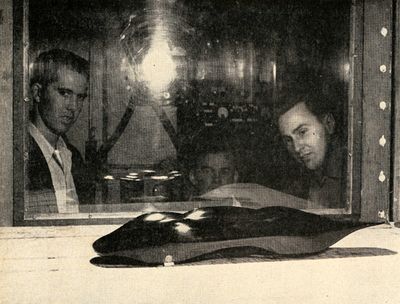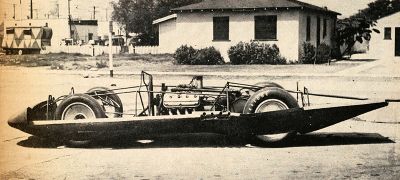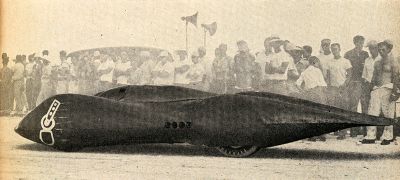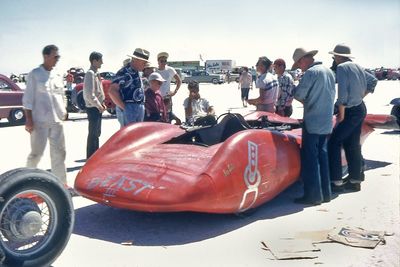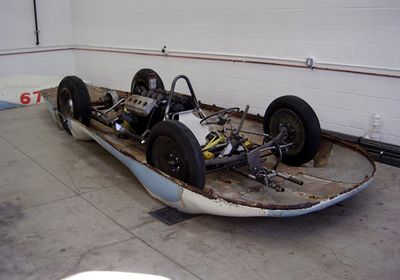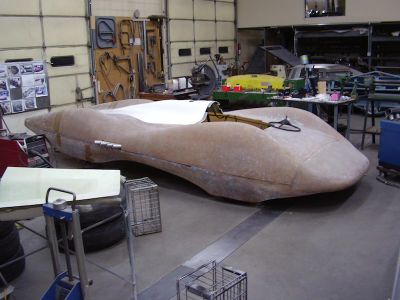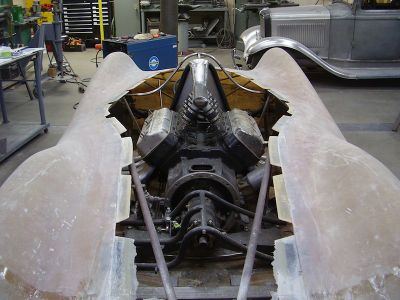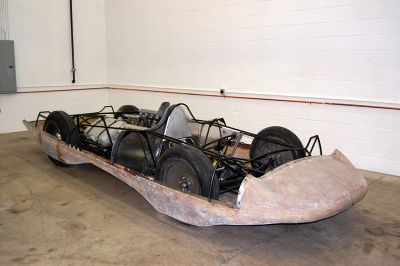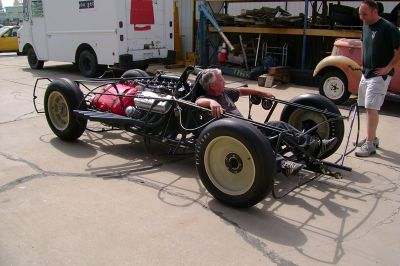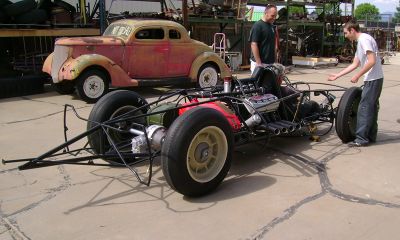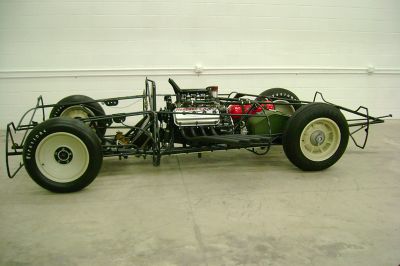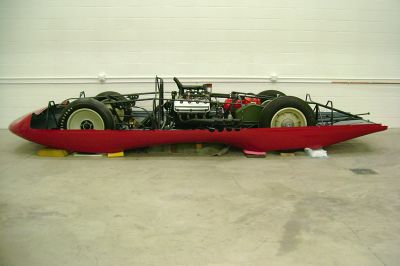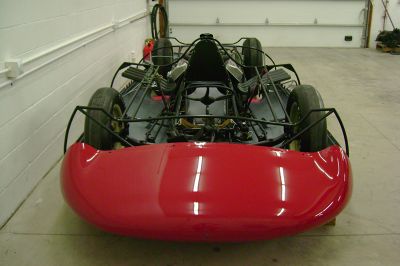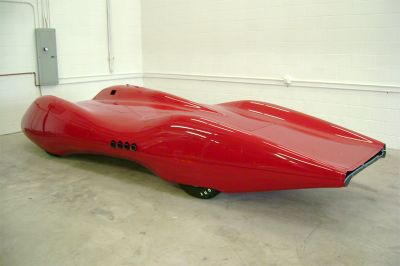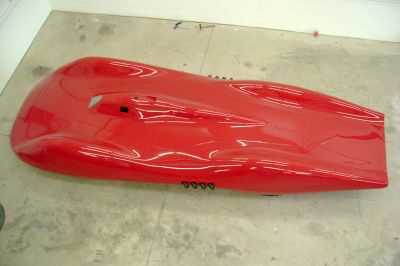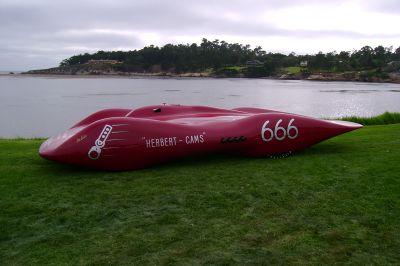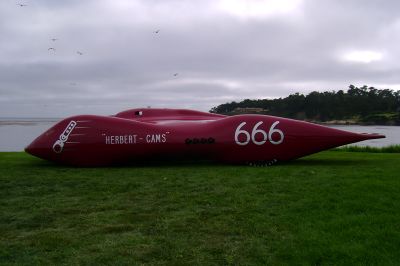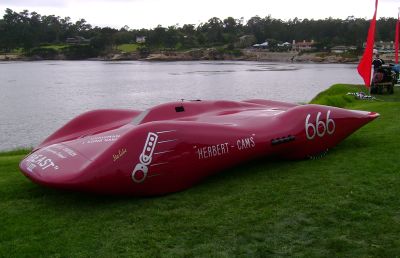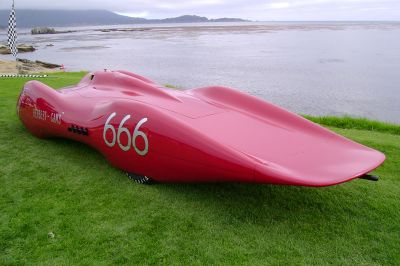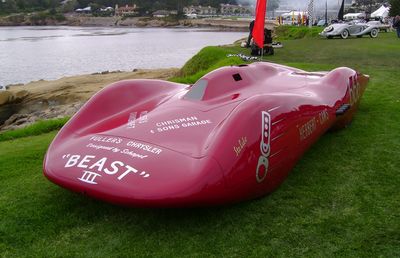Chet Herbert's Beast III
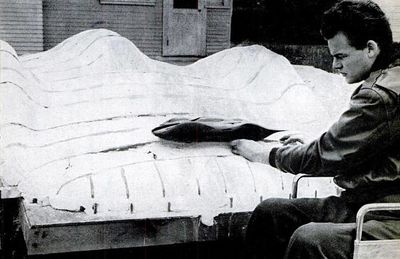
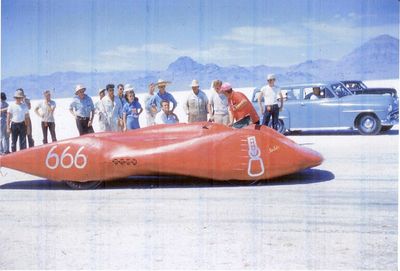

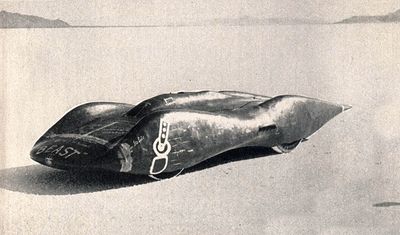
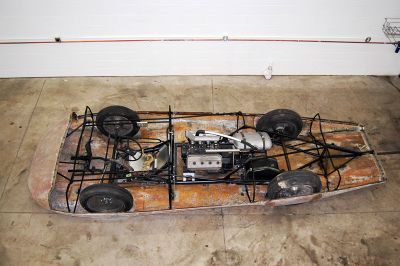
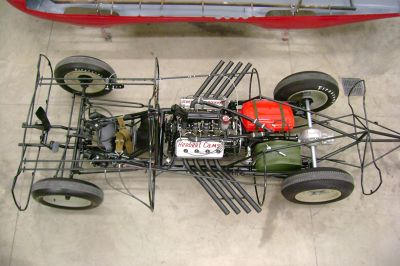
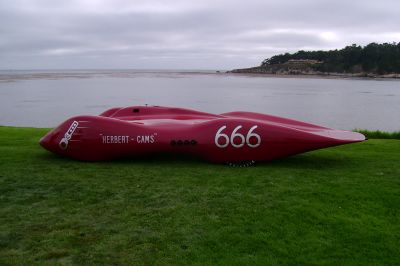
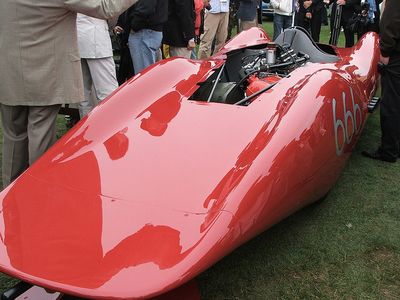
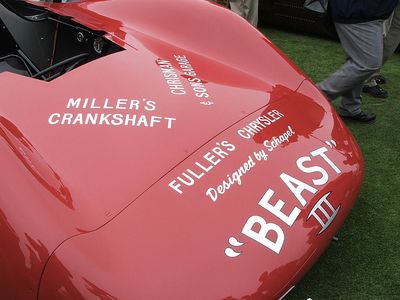
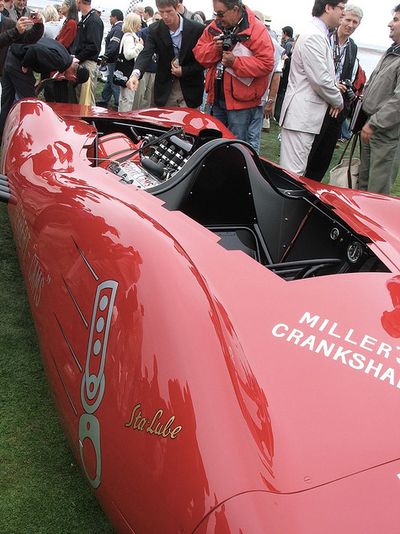
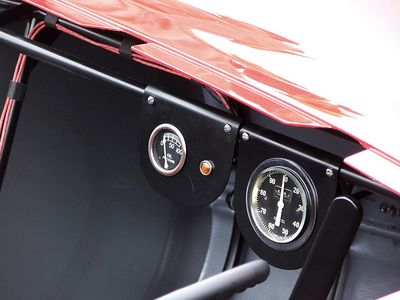
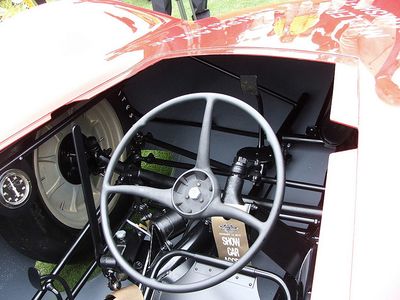
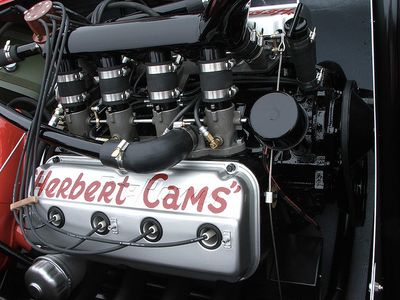
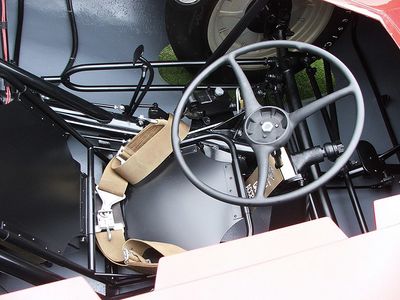
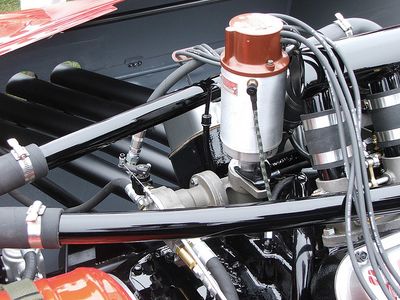
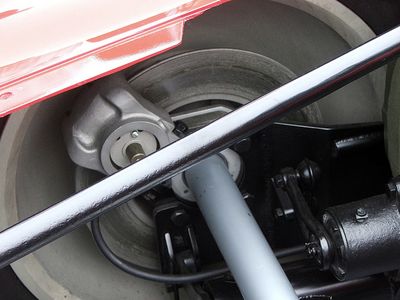
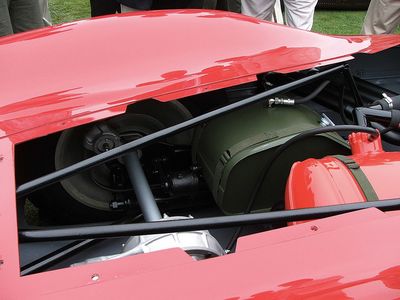

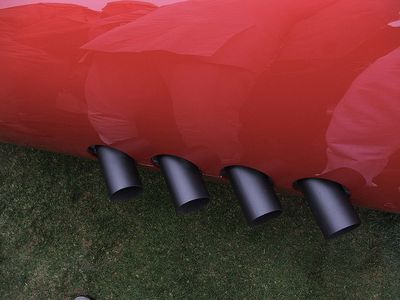
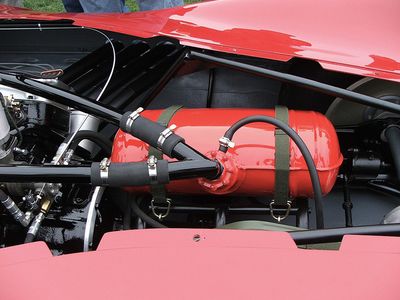
The Beast III is a Streamliner built by Chet Herbert in 1952. Encouraged by the success he had with his Beast I and II, Chet wanted to build a Bonneville Streamliner from scratch. During his research for the build, Chet learned about an engineer working as a consultant at Cal Tech's wind tunnel named Rod Schapel. Schapel was a mechanical engineer assigned to study the behavior of airplanes under various stresses and loads. Herbert and Schapel hit it off instantly and set about to design and build a streamliner like no other based on aerodynamic computations. The plan was to build the car and have it ready to race at Bonneville in August of 1952. With only months to build the Streamliner the team set to work quickly.[2]
When Schapel began designing the Streamliner for Chet, he hadn't been to Bonneville and he had never seen a Streamliner before. But he jumped into the project, and started by creating a 1/10th scale model formed from aluminum following clay and wood patterns. The model was used in a series of wind tunnel tests. With test data in hand, they refined the shape to increase speed and stability. After finalizing the model's form, it was time to build the full-scale body. Chet and Rod decided to build the car in fiberglass due to its lightweight and uniformed construction characteristics. Schapel began by lofting full-sized sections of the body in his own backyard. The hand lay-up body and the molding process took approximately two months to complete. The male mold required to build the body was such a massive structure that, in the end, Schapel’s only option to return the backyard to his family was to cut the mold up and discard it, making the Beast III a one of a kind creation.[2]
The chassis for the Beast III was a partially completed unit with two 3-inch tubular sections that Herbert sourced from Paul Sylvia of Inglewood, California. Front suspension was by torsion bar and rear suspension was torsilastic. In order to accommodate a mid-mounted engine, Herbert reconstructed the chassis so the driver was moved forward. The cover of Hot Rod Magazine December 1952 shows Herbert working on the chassis from his wheel chair. The completed build had a wheelbase of 108". Herbert originally wanted to fit the Beast III with a modified aluminum 330 cubic inch 6 cylinder Franklin engine, just like Preston Tucker planned for his Tucker 48, but the engine self-destructed during dyno testing, so he decided to go for a Chrysler Hemi instead.[2] Truck fleet owner Dana Fuller of San Mateo, California was a friend of Herbert’s and agreed to loan him the engine as his brand new Chrysler Imperial happened to be in Chet's shop having a roller cam installed.[1] Herbert heavily modified the 1951 Chrysler Hemi monster and equipped it with a Hilborn-Travers fuel injection and a Vertex magneto. Four individual exhaust stacks were fabricated with precision and fit to exit through each side of the body.[2] A factory stock Dodge truck clutch and an early 1940s Chrysler flywheel were bolted to the Hemi.[1] The engine was hooked to a Ford V-8 side shift transmission with a cook adapter. A Halibrand quick-change tube axle unit with an aircraft type spot brake brought the power out to a pair of 18 inch smooth cast Halibrand magnesium wheels riding on Firestone Bonneville racing tires. The brake and shift levers were hand operated, while the clutch and accelerator pedals were foot operated.[2]
The two-piece fiberglass body for the Beast III was completed and delivered to Chet's shop after the 1952 Bonneville Nationals had started. Once delivered Chet realized that he needed help in order to get the Streamliner done, so the pieces were taken to Chrisman & Sons Garage in Compton where the body was was assembled by Art Chrisman, Lloyd Chrisman, their father and a host of others.[1] At the end the car was completed with volunteer labor. Some of the guys were working jobs during the day so they could only come at night; they worked around the clock. As Chet couldn't count on who was coming, he stayed there all the time for three or four days, awake the whole time and working. In the end he was so tired that they had to tie him in the wheelchair with a belt so he wouldn't fall out. Finally arriving at the Bonneville Nationals August 27, the fifth day of the meet, the car was entered as the "Herbert Cams Special". The car ran as a D-streamliner, and got the number 666.[2] George Bentley drove the maiden run to a top speed of 182 mph, with two followup runs at 197 and 211 mph. At the third run, Bentley missed a shift and tore the clutch out. The Dodge clutch and Chrysler flywheel Herbert used on the Hemi engine turned out to be a bad choice of parts, as the clutch package developed a serious slippage problem, and had to be bolted directly to the flywheel in order to make the record runs.[1] The next morning Bentley didn't show up at the salt. The crew kept the car in line and kept waiting for George to appear. As they got close to the front, they pulled out of the line and started all over again. They did this three or four times before Art Chrisman took over the controls and ran 219, 224, 230 and finally an amazing 235.991 mph with a one-way best mark of 238.095 mph to set the class D/Streamliner record. This run established the Beast III as the fastest single-engine car in America.[1] Running the Beast III, Art became a member of the 200 mph club at the 1952 Bonneville Nationals, making him the 10th ever inductee, quite an accomplishment for a substitute driver. Because of the improvised direct drive configuration, the team had to come up with a way to get the car going fast enough that they could start it and get it running. The solution was to use two push cars. Three cars nose to tail left the starting line with a stock street early 1950s Chevy Coupe pushing Howard Johansen's 1929 Ford Model A Roadster and the Beast III. When the three cars reached 70 mph, the Chevy backed off, and "Howard Cams Special" pushed the Beast III to 130 mph. [3] Chet's crew at the 1952 Bonneville Nationals consisted of Art Chrisman, Lloyd Chrisman, Rod Schapel, Dana Fuller, Howard Johansen, Harold Miller, Ed Losinski, and Roy Reed.[2]
In 1953 Chet partnered with Dana Fuller who ran the reconstructed Streamliner with a 425 cubic inch 6-71 GMC diesel engine equipped with an experimental head and twin superchargers. With this configuration Dana drove the Streamliner to two world records for diesel powered cars at the 1953 Bonneville Nationals.[3] In 1955 the Beast III was retired and put away in storage.[4] In 2002, land speed racer Ed Hegarty bought the car from the Fuller family. Hegarty planned to get the old Streamliner running, but as time passed the car sat idle for another 7 years. In June of 2009, the Streamliner was unearthed by Dave Crouse of Custom Auto in Loveland, California and collector Mark Brinker of Houston, Texas. The Streamliner was still in Ed Hegarty's shop and when Mark bought it, it hadn't been raced since the mid 1950s, and it was very well preserved. When the project arrived at Custom Auto for its restoration, it still had the original body and a little over 70% of the original Herbert birdcage chassis structure as raced in 1952. Almost all of the structure was used in the restoration.[5]
The restored version of the Beast III made its first appearance August 15, 2010 at the 60th annual Pebble Beach Concours d'Elegance where 10 legendary dry lakes racers were invited to compete in their own class. The Beast III took the second prize trophy in its class. Following Pebble Beach, the car was invited to be on display at The Petersen Automotive Museum in Los Angeles until February 2011. After that, Brinker planned on racing the car at the Texas Mile speed event in Goliad, Texas.[2]
Mark Brinker donated the car to the Wally Parks NHRA Motorsports Museum, and the new exhibit that featured the Beast III opened in the Summer of 2014.[6]
Magazine Features
Popular Mechanics August 1952
Hot Rod Magazine December 1952
Hop Up July 1953
Trend Book 110 Hot Rod 1954 Annual
References
External Links
Did you enjoy this article?
Kustomrama is an encyclopedia dedicated to preserve, share and protect traditional hot rod and custom car history from all over the world.
- Help us keep history alive. For as little as 2.99 USD a month you can become a monthly supporter. Click here to learn more.
- Subscribe to our free newsletter and receive regular updates and stories from Kustomrama.
- Do you know someone who would enjoy this article? Click here to forward it.
Can you help us make this article better?
Please get in touch with us at mail@kustomrama.com if you have additional information or photos to share about Chet Herbert's Beast III.
This article was made possible by:
SunTec Auto Glass - Auto Glass Services on Vintage and Classic Cars
Finding a replacement windshield, back or side glass can be a difficult task when restoring your vintage or custom classic car. It doesn't have to be though now with auto glass specialist companies like www.suntecautoglass.com. They can source OEM or OEM-equivalent glass for older makes/models; which will ensure a proper fit every time. Check them out for more details!
Do you want to see your company here? Click here for more info about how you can advertise your business on Kustomrama.
